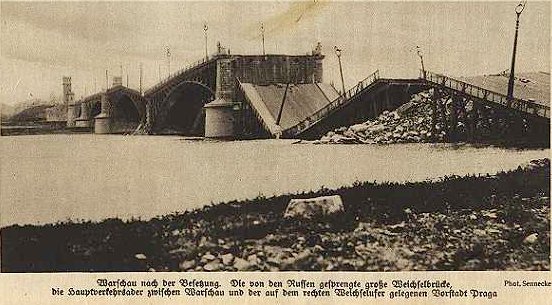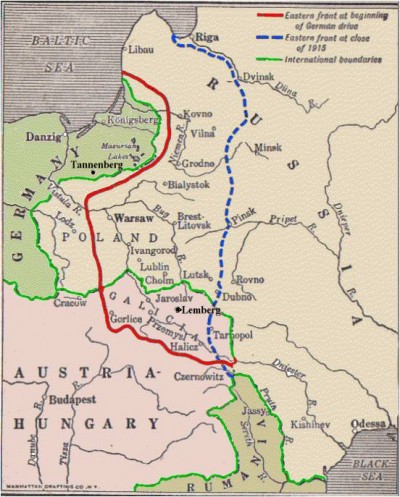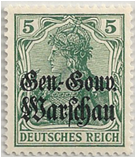ALBUM – view my German Occupation of Poland in WW1 Album
Fast Facts
Region: Germany / Poland Area
Group: German Occupation is WW1
Classification: Military Occupation (Germany)
Prior Regime: Russian Empire
Key Dates:
1915 – Germany invades Poland, driving out the Russians
1918, Oct/Nov – German forces withdraw from Polish lands
1918, Nov 11 – Poland declares itself and independent state
1923 – Official Boundaries of Poland set
Following Regime: Republic of Poland
Scott Catalogue: (Poland, Occupations) #N1-N16
Pick Catalogue: Russian Poland – (Poland, German occupation of Russian part of Poland) #1-16
East Poland – (Germany) R120-R134 (occupation of Lithuania, Latvia, Belarus and E.Poland)
History

The history of Poland is complex and convoluted. Although Poland has had a separate and distinct culture and identity for over a thousand years, it has mostly been under the direct control of the stronger nations and empires which surrounded it.
During the period of 1772 – 1795, Poland was conquered and partitioned by three of the ruling powers of the day, Prussia, Russia and Austria. Poland ceased to exist as a national identity in 1795, when the King of what was left of Poland was forced to abdicate and taken to St. Petersburg (where he died in 1798). Even with a revolution in 1798 led by Tadeusz Kościuszko, a hero of the American War of Independence, the Polish forces were defeated by the stronger Russian forces within a year.
While the Congress of Vienna in 1815 established the Kingdom of Poland, in reality it was established as a province of the Russian Empire. With the outbreak of World War 1 in 1914, Poland was quickly invaded by Germany and Austrio Hungary. Many of the significant battles on the Eastern Front during World War 1 were fought in Polish lands, resulting in staggering losses of life among the Poles. With no Polish army to fight for a national cause, approximately two million Poles were conscripted into the Russian, German or Austrian armies, forced to fight one another. With the poor performance of the Austrian Army on the Eastern Front and Emperor Karl’s attempt to exit the war, Germany quickly assumed command of the entire region, seizing Warsaw in 1915 and much of eastern Poland by 1916. While a Council of State was organized for a declared “Kingdom of Poland”, the Germans retained absolute control.
 With the collapse of the Russian Empire in 1917, and the defeat of Germany and Austria in 1918, the Germans withdrew from Poland allowing Józef Piłsudski to command of Warsaw on 11 November 1918 and declared Polish sovereignty. This was confirmed by the Treaty of Versailles in 1919, where Poland was given the western part of Prussia, providing access to the Baltic Sea. The city of Gdańsk, was omitted, becoming the Free City of Danzig, and the rest of Poland’s western border was drawn up in a series of plebiscites, which resulted in Poland acquiring some significant industrial regions of Upper Silesia. The eastern boundaries were established when Polish forces defeated the Red Army during the Polish-Soviet war of 1919–20.
With the collapse of the Russian Empire in 1917, and the defeat of Germany and Austria in 1918, the Germans withdrew from Poland allowing Józef Piłsudski to command of Warsaw on 11 November 1918 and declared Polish sovereignty. This was confirmed by the Treaty of Versailles in 1919, where Poland was given the western part of Prussia, providing access to the Baltic Sea. The city of Gdańsk, was omitted, becoming the Free City of Danzig, and the rest of Poland’s western border was drawn up in a series of plebiscites, which resulted in Poland acquiring some significant industrial regions of Upper Silesia. The eastern boundaries were established when Polish forces defeated the Red Army during the Polish-Soviet war of 1919–20.
Stamps
 ALBUM
ALBUM
The first issue for German occupied Russian area of Poland was released 12th May 1915 and consisted of 5 stamps from the German Empire overprinted “Russisch-Polen” (Russian-Poland). A year later, German occupational forces begin issuing overprinted a further issue overprinted this time with “Gen.-Gouv.-Warschau” was placed on sale, containing 11 stamps (some were issued in 1917 when postal rates changed). German occupied Poland had been renamed “General-Gouvernment of Warsaw”.
Banknotes
Prior to the occupation, Russian rubles were used. Upon the invasion and occupation of Poland, German Occupation forces issued different banknotes depending on the zone of occupation.
For the Russian part of Poland, two sets of banknotes were issued. In 1916, notes in the denomination of 1/2, 1, 2, 20, 50, and 100 marks were issued. Another issue with updated designs came later in 1916-1917, and were issued in the denominations of
1/2, 1, 2, 5, 10, 20, 100, and 1.000 marks
For the occupational terratories of Lithuania, Latvia, Belarus and E.Poland. Banknotes in kopeks and rubles (20k, 50k, 1r, 3r, 10r, 25r and 100r) were issued in 1916, and notes in marks (0.5m, 2m, 5m, 20m, 50m, 100m and 1000m) were issued in 1918
Links
Occupation stamps of Poland in WW1
Banknotes of Poland (includes occupational issues)





Dear Patricia….. Hi _ I ran across your question quite by accident. I may be able to help. I have a cousin living in Poland, Andrea (Andrzej Szymanski), who has done a lot of research on my family ….on my father’s side. My dad arrived from Poland in 1913 into Baltimore. He came from near Sandomierz. We have a family tree on Geni which shows relations to Jadwiga Gogolowa. Jadwiga is not a good clue since it is a first name I believe but there is a slim chance Jadwiga Gogolowa is in your family tree. If you like, I can contact a cousin of mine in Poland to see if he can find out any information about you father…. He is really good at tracing heritage. Regards Leonard Lipinoga
I am trying to trace my Polish background on my father’s side. My grandfather Alexander Szymczyk was a stow away on a boat that arrived in NY in the early 1900’s. He settled in Amsterdam NY in a Polish/Russian poor neighborhood in that town. My grandfather had brothers name John, Frank and Joseph. Joseph returned to Poland and owned a farm in Szablak and became a constable I believe. Upon his death the farm was inherited by a cousin named Jadwiga. The brother’s father may have been named Tadeuz and may have been a Catholic Polish miltary leader who was killed by the enemy. Alexander Szymczyk marries Stanislawa Zadrozny (spelling?). Can you help me?
Dear Patricia, welcome to DCStamps.
I am sorry, there is not much I can do to help your, but I would suggest you try some of the genealogical sites.
Michael